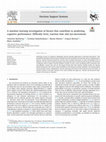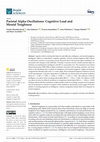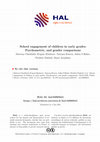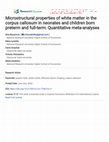Papers by Marie Arsalidou

Decision Support Systems, 2022
Predicting accuracy in cognitively challenging tasks has potential applications in education and ... more Predicting accuracy in cognitively challenging tasks has potential applications in education and industry. Task demand has been linked with increases in response time and variations in reaction time and eye-tracking metrics, however, machine learning research has not been used to predict performance on tasks with multiple levels of difficulty. We report data on adult participants who performed tasks of mental attentional capacity with six levels of difficulty and use machine learning methods to predict accuracy scores considering metrics associated with task difficulty, reaction time and eye movements. Results show that machine learning models can robustly predict performance with reaction times and difficulty level being the strongest predictors. Eye-tracking indices can also predict accuracy independently, with the most important features of the model driven by the number of fixations, number of saccades, duration of the current fixation and pupil size. Practical and theoretical implications of the results are discussed.

Brain Sciences
Cognitive effort is intrinsically linked to task difficulty, intelligence, and mental toughness. ... more Cognitive effort is intrinsically linked to task difficulty, intelligence, and mental toughness. Intelligence reflects an individual’s cognitive aptitude, whereas mental toughness (MT) reflects an individual’s resilience in pursuing success. Research shows that parietal alpha oscillations are associated with changes in task difficulty. Critically, it remains unclear whether parietal alpha oscillations are modulated by intelligence and MT as a personality trait. We examined event-related (de)synchronization (ERD/ERS) of alpha oscillations associated with encoding, retention, and recognition in the Sternberg task in relation to intelligence and mental toughness. Eighty participants completed the Sternberg task with 3, 4, 5 and 6 digits, Raven Standard Progressive Matrices test and an MT questionnaire. A positive dependence on difficulty was observed for all studied oscillatory effects (t = −8.497, p < 0.001; t = 2.806, p < 0.005; t = −2.103, p < 0.05). The influence of Raven ...

PLOS ONE
School engagement reflects the degree to which students are invested, motivated and willing to pa... more School engagement reflects the degree to which students are invested, motivated and willing to participate in learning at their school and this relates to future academic and professional success. Although school engagement is a primary factor predicting educational dropout or successful school completion in Europe and North America, little is known about school engagement factors in non-English speaking countries. We adapted a 15-item school engagement scale and assessed validity and reliability of the Russian translation on a sample of Russian school-aged children (N = 537, 6-12 years, 46% females) who attended at public schools in Moscow. Results of the final factorial structure that included emotional, cognitive and behavioral components were selected based on its excellent fit indices and principles of parsimony. Component results show that the emotional component has the highest internal consistency and the behavioral component has the lowest. Although, all components are significantly interrelated, we observed no gender differences and no significant correlation with age. Theoretically, our data agree with the notion that children's emotional engagement in schools sets the foundation for learning, participating and succeeding in school activities. Practically, the proposed scale in Russian can be used in educational and clinical settings with Russian speaking children.

Nearly 15 million infants are born preterm every year. Research shows that compared to their full... more Nearly 15 million infants are born preterm every year. Research shows that compared to their full-term peers, individuals born preterm are more likely to have lower academic scores and be less wealthy later in life. Some suggest that brain connectivity as measured by diffusion tensor imaging (DTI) may underly these results. Critically, these differences have not been substantiated quantitatively. We performed quantitative meta-analyses to evaluate overarching patterns from articles that reported DTI metrics from the corpus callosum (CC), the largest white matter structure in the brain, in neonates and children/adolescents who were born pre-term and full-term. The DTI literature was reviewed using PRISMA (Preferred Reporting Items for Systematic Reviews and Meta-Analyses) guidelines. Two meta-analyses, considering publication bias and study heterogeneity, were performed onfractional anisotropy scores from the CC from eligible articles that scanned individuals at 39.9±1.1 weeks (i.e.,...
Journal of Experimental Child Psychology
Output: Ginger ALE meta-analysis: Contrast studies results
Output: Meta-regression on age + study heterogeneity maps (QH)
Output: meta-regression on Acc: middle + study heterogenity map (QH map)
Output: meta-regression RT adults
Output: meta-regression accuracy adults
Output: Meta-regression Negative trend of age

Human Brain Mapping, 2020
Functional magnetic resonance imaging (fMRI) studies have shown notable agedependent differences ... more Functional magnetic resonance imaging (fMRI) studies have shown notable agedependent differences in reward processing. We analyzed data from a total of 554 children, 1,059 adolescents, and 1,831 adults from 70 articles. Quantitative meta-analyses results show that adults engage an extended set of regions that include anterior and posterior cingulate gyri, insula, basal ganglia, and thalamus. Adolescents engage the posterior cingulate and middle frontal gyri as well as the insula and amygdala, whereas children show concordance in right insula and striatal regions almost exclusively. Our data support the notion of reorganization of function over childhood and adolescence and may inform current hypotheses relating to decision-making across age. K E Y W O R D S adolescents, children, developmental neuroscience, fMRI meta-analysis, reward processing 1 | BACKGROUND Etymologically, "reward" derives from Old French "regard" and corresponds to a prize or wage in exchange for some service. Humans experience reward regularly, a process that encompasses a broad range of decision-making phenomena including risky decision-making (Mohr,

Psychology. Journal of the Higher School of Economics, 2017
A small percentage of children shows outstanding cognitive abilities and perform at m uch higher ... more A small percentage of children shows outstanding cognitive abilities and perform at m uch higher levels th an their same age peers. Psychological science has absorbed knowledge from different spheres such as psychometrics, mathematics, statistics, and psychology to develop m ethods for identifying cognitively gifted children. The study of intelligence has a long history and has been influenced by social environm ent, wars, education systems and revolutions. In this paper we focus on tw o main techniques of identifying cognitively gifted children (a) intelligence testing and (b) domain specific exams called Olympiads (e.g., m ath and physics). We provide a short his torical perspective of th e evolution of intelligence testing in Europe and th e U SA and domain specific Olympiads in Russia. We discuss advantages and lim itations of b oth techniques. Moreover, we highlight th a t cognitive neuroscientists have been trying to understand th e brain mechanisms th a t may drive cognitive abilities in highly performing children using neuroimaging techniques such as functional magnetic resonance imaging (fM R I). We summarize th e know l edge we gained to date from fM RI studies and show th a t th e m ajority of studies examine m ath ematically gifted male adolescents w ith m ental rotation tasks. Despite critical advances there is still a lot to be done in understanding th e semantic brain-behavior relations in cognitively gifted children.

The analysis of cognitive competence can predict the level of a child’s development and, thus, ca... more The analysis of cognitive competence can predict the level of a child’s development and, thus, can play an important role in their future academic progress. Although the majority of children show comparable cognitive performance for their age, some children significantly outperform their peers of the same age. Based on the Theory of Constructive Operators (TCO), children’s mental attentional capacity (i.e., the number of items that a child can simultaneously manipulate in their mind) normally increases from about 3 units when they enter school to about 7 units when they finish. In this study, we use parametric visual-spatial measures of mental-attentional capacity to examine whether we can identify cognitively gifted children. In contrast to intelligence tests, which are still a popular measure of giftedness, mental-attentional capacity measures do not depend on context knowledge and have already been used in Canada, South America, Europe, and Australia (Arsalidou & Im-Bolter, 2017)...

The Russian Journal of Cognitive Science, 2020
A study by Giffin and colleagues (2017) found the effect of a verbal label on the explanation of ... more A study by Giffin and colleagues (2017) found the effect of a verbal label on the explanation of an unfamiliar phenomenon: when a name is used, people's judgments are more likely to express the belief that the phenomenon has an objective cause. This effect was demonstrated in behavior descriptions of a mental disorder that was either labeled with the fictional name “depataphy” or left unlabeled. In the present study, we replicated this effect (N = 110) and added new conditions in order to assess whether another linguistic form, a metaphor, could cause the same effect. A separate group (N = 119) evaluated two conditions wherein, instead of a verbal label, we informed participants that the internal state of the person behaving abnormally can be compared to some other event (e.g., a fire). One condition (the so-called nonconventional metaphor) emphasized that this comparison is made by the character of the story himself, and the second condition emphasized other people with a simil...











Uploads
Papers by Marie Arsalidou